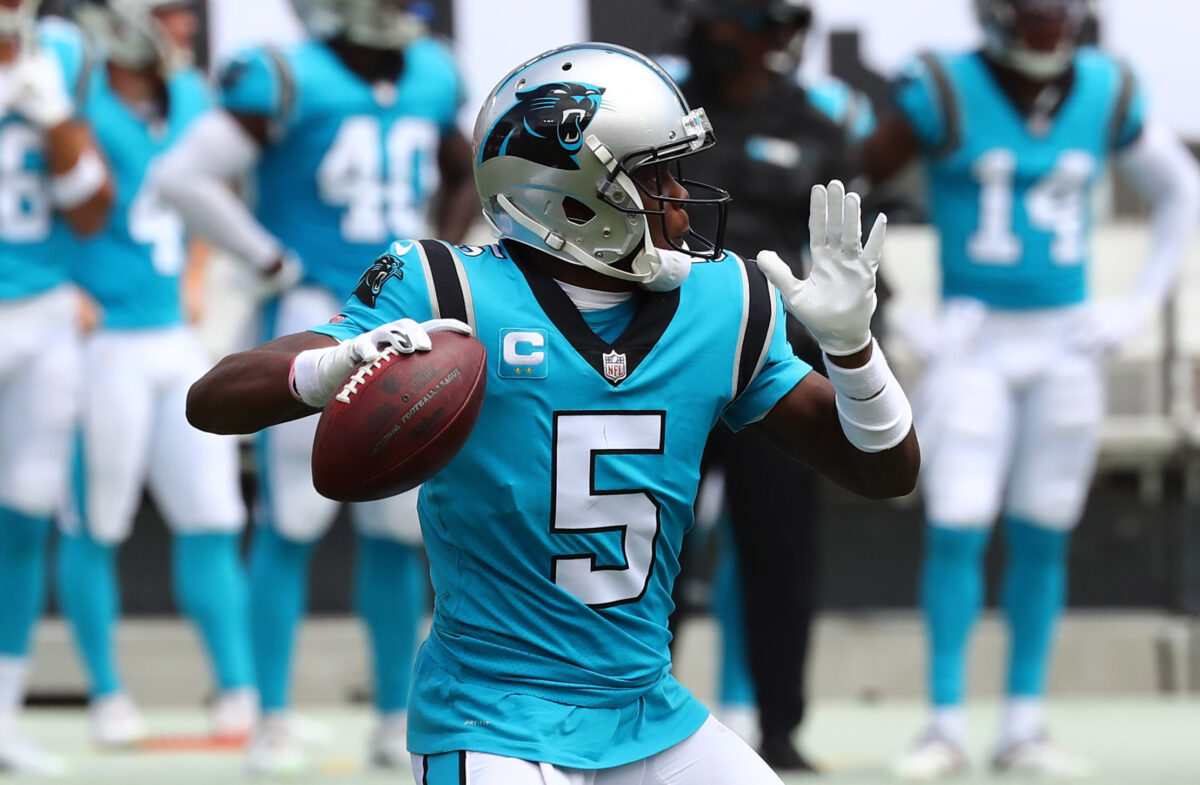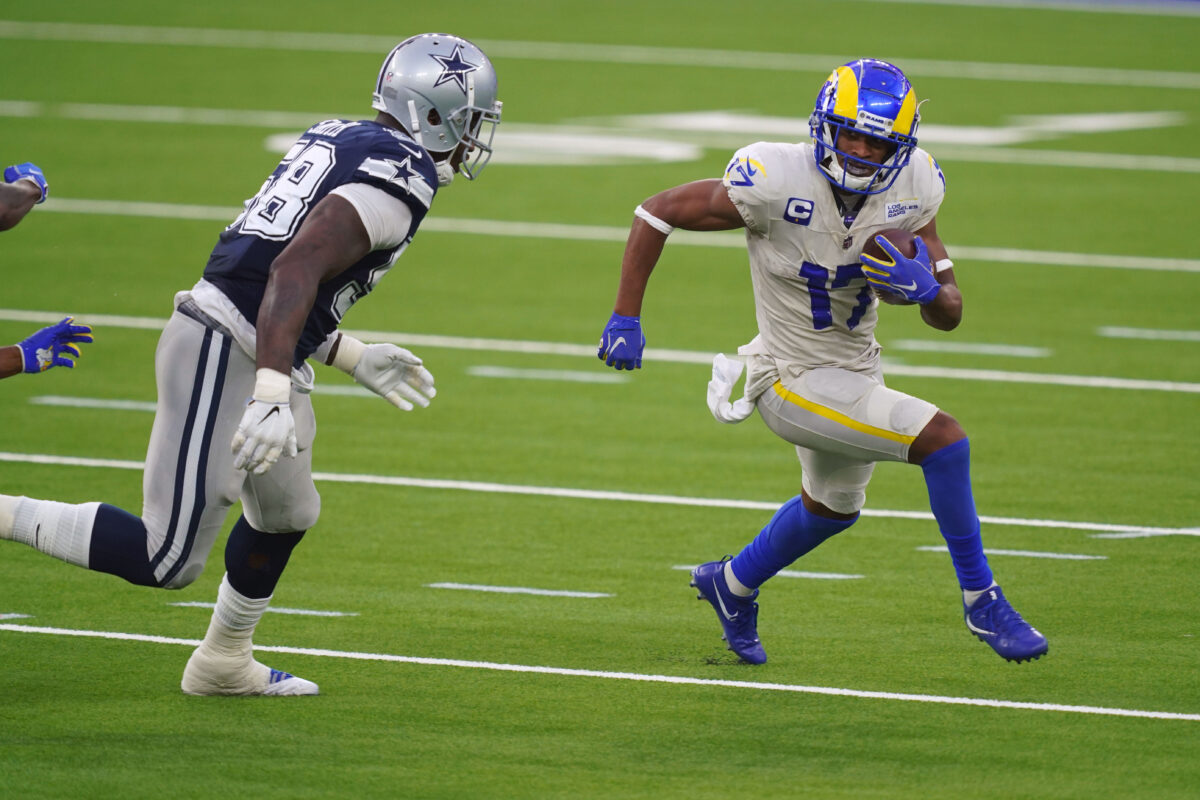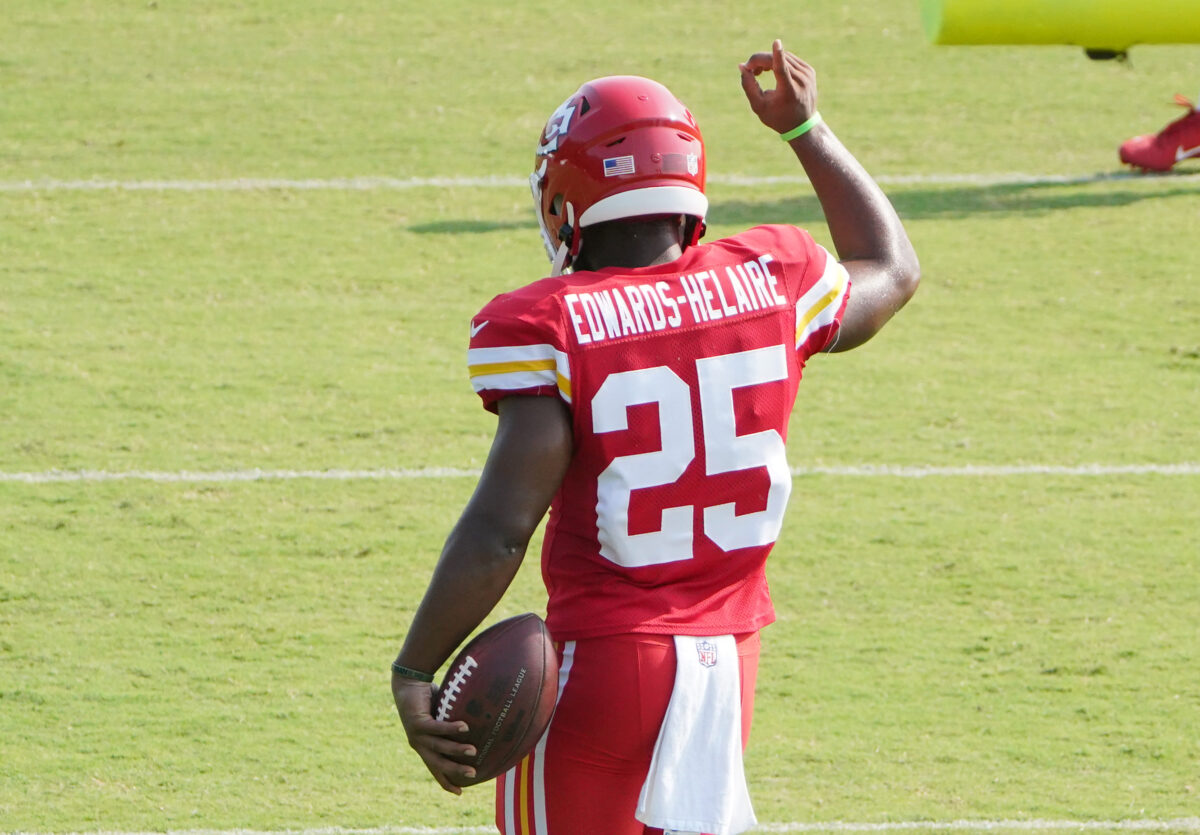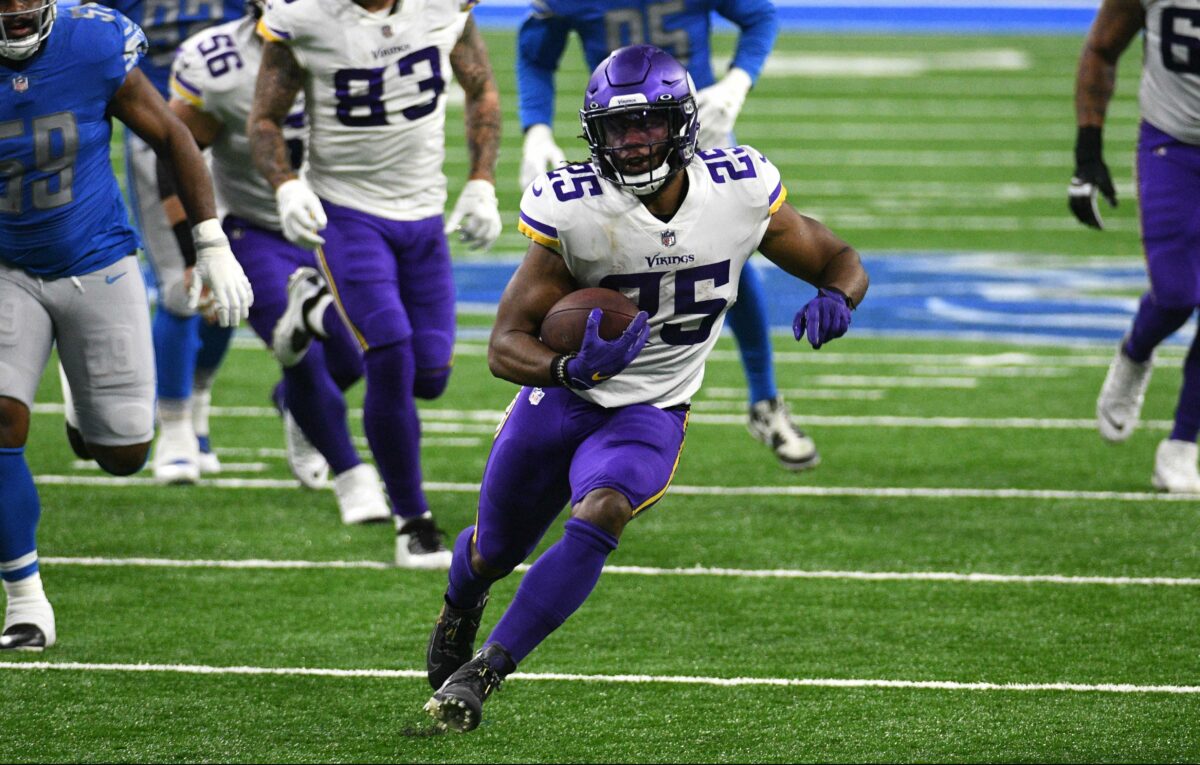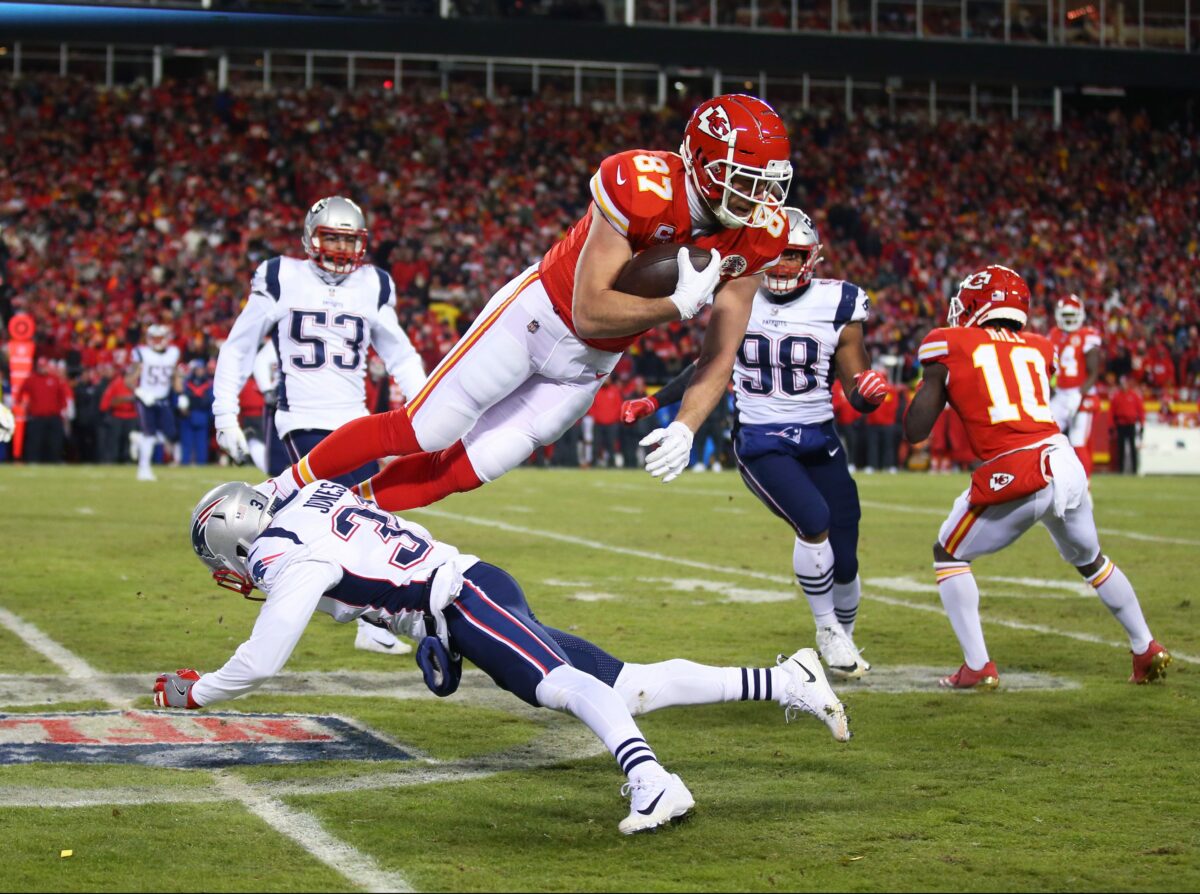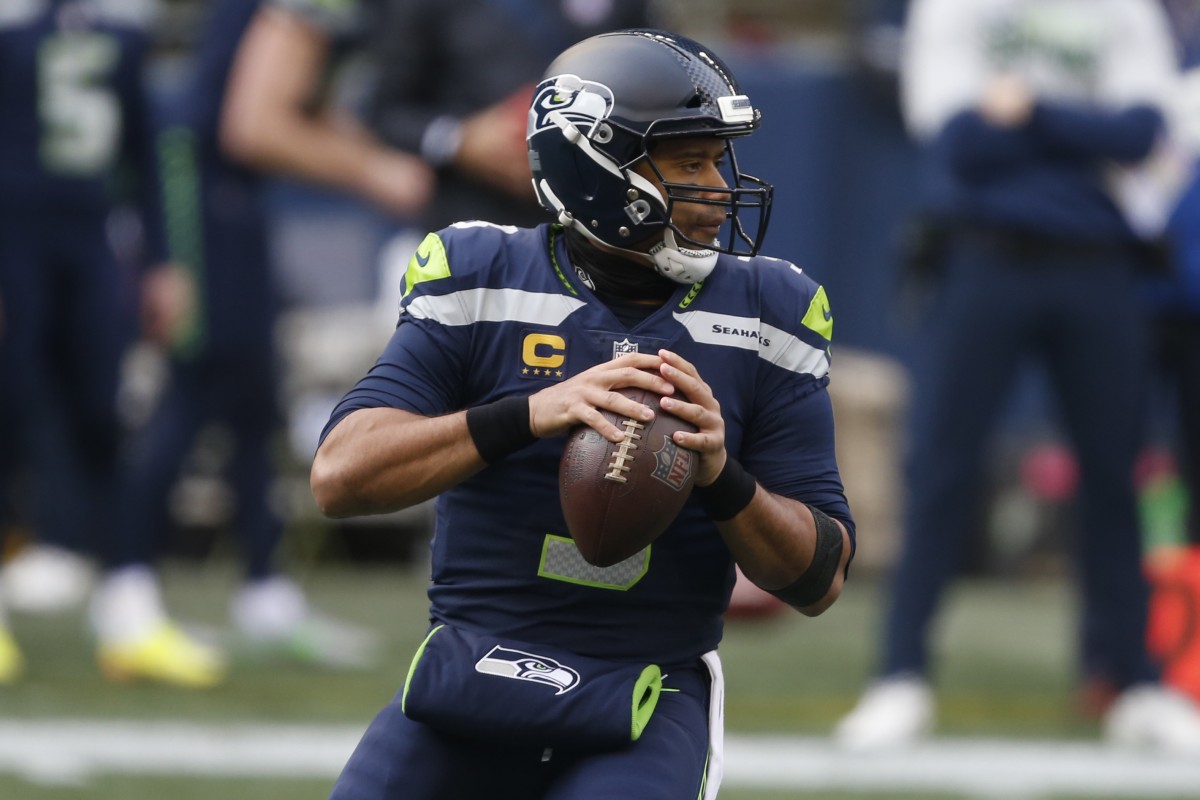Your first three picks define your fantasy football team. Each pick is critical because the player pool is ever-shrinking, and you have to select a mixture of available players to produce an optimal team. And those initial rounds determine what you’ll do in the later rounds of the draft. Get them wrong and you may not be able to recover.
To follow are sample three-round drafts for 12-team fantasy football leagues. They use either standard performance scoring, performance plus a point per reception, or “2QB/Super Flex” leagues where you can start two of any position. Those three formats cover virtually all leagues.
The names are less important than the positions because each draft slot has its own unique situation. Just as important are your future picks and what you need after three rounds. Rankings can change daily so these may not exactly match site rankings. Pay the most attention to the positions and how they work together for an optimal start.
Performance scoring league
|
Round 1 |
|
Round 2 (reverse) |
|
Round 3 |
| 1.01 |
RB Christian McCaffrey |
2.12 |
RB Josh Jacobs |
3.01 |
WR DeAndre Hopkins |
| 1.02 |
RB Dalvin Cook |
2.11 |
QB Patrick Mahomes |
3.02 |
RB J.K. Dobbins |
| 1.03 |
RB Derrick Henry |
2.10 |
WR DK Metcalf |
3.03 |
RB D’Andre Swift |
| 1.04 |
RB Alvin Kamara |
2.09 |
RB Clyde Edwards-Helaire |
3.04 |
QB Josh Allen |
| 1.05 |
RB Nick Chubb |
2.08 |
WR Justin Jefferson |
3.05 |
WR CeeDee Lamb |
| 1.06 |
RB Jonathan Taylor |
2.07 |
RB Saquon Barkley |
3.06 |
WR A.J. Brown |
| 1.07 |
RB Ezekiel Elliott |
2.06 |
WR Calvin Ridley |
3.07 |
TE Darren Waller |
| 1.08 |
TE Travis Kelce |
2.05 |
RB Aaron Jones |
3.08 |
RB Mike Davis |
| 1.09 |
RB Joe Mixon |
2.04 |
RB Chris Carson |
3.09 |
WR Keenan Allen |
| 1.10 |
WR Stefon Diggs |
2.03 |
RB David Montgomery |
3.10 |
RB Kareem Hunt |
| 1.11 |
RB Najee Harris |
2.02 |
WR Davante Adams |
3.11 |
RB Myles Gaskin |
| 1.12 |
WR Tyreek Hill |
2.01 |
RB Antonio Gibson |
3.12 |
QB Kyler Murray |
Performance scoring without reception points means that running backs are a premium and quarterbacks are a bit more valuable. Wide receivers and tight ends are devalued but are still usually four starters in a fantasy football league. Almost all teams will look to get two running backs in their first three picks and it’s hard to argue against the logic because the supply is very low by round four.
Team 1: RB Christian McCaffrey, RB Josh Jacobs, WR DeAndre Hopkins
Starting with the top player in the draft usually means having more freedom with the next picks since you already have an advantage and are not locked into a need pick. In this case, team opted to pair McCaffrey with the best available rusher and receiver for a solid and safe start. Next up – is likely a quarterback, but the base has been set and wideouts can wait in this format.
Team 2: RB Dalvin Cook, QB Patrick Mahomes, RB J.K. Dobbins
This plan better addresses the realities of player value with no reception points. Obvious pick with Cook turned into scooping the top quarterback in Patrick Mahomes. Grabbed RB2 in the third round for a very effective start. Quarterbacks are more valuable in this format, so reaching the top player at the end of the second round makes sense. Next up – consider a wideout before the position becomes a liability.
Team 3: RB Derrick Henry, WR DK Metcalf, RB D’Andre Swift
Started with Derrick Henry who is a beast in this scoring format, then opted for DK Metcalf in the second. That let him control which wideout he took as the sixth overall and then address RB2 with upside pick of J.K. Dobbins. Next up – probably looking at quarterback or another running back.
Team 4: RB Alvin Kamara, RB Clyde Edwards-Helaire, QB Josh Allen
Nice start in this scoring format that needed a top running back, high upside with Clyde Edwards-Helaire and then opted for the No. 2 quarterback in Josh Allen. Solid start to be sure. Next up – look at wideouts or a third running back if one has fallen in the draft.
Team 5: RB Nick Chubb, WR Justin Jefferson, WR CeeDee Lamb
While this plan doesn’t appear to honor the scoring format as much, it really sort of does. Solid start at running back was joined by two wideouts even without reception points. The plus here is that while wideouts do not score as much in this format, they still matter and the team now owns two Top-10 players in that position. That is an advantage in a position he can now leave alone for several rounds while searching for value picks. Up next – should consider two running backs and a quarterback in the next three rounds.
Team 6: RB Jonathan Taylor, RB Saquon Barkley, WR A.J. Brown
Standard “middle of the draft” path that is safe. Start with two backs that mean the position may be a strength and should not be a liability. Then opting for a difference-making wide receiver before that quality wanes. This is very safe in this format. Next up – Can go anywhere, should consider running back in the fourth before value evaporates but can consider quarterbacks along the way as well.
Team 7: RB Ezekiel Elliott, WR Calvin Ridley, TE Darren Waller
Continued the run on running backs and still ended up with Ezekiel Elliott. Then they reached a Top-5 wide receiver in Calvin Ridley and the No. 2 tight end with Darren Waller. No reception points depress their contributions, but they still represent an advantage in points against other fantasy teams. Next up – have to consider running backs the next two rounds unless someone else falls. Quarterback is down the road in this one. Has to catch up with running backs before the position is a liability which is more damaging in this scoring format.
Team 8: TE Travis Kelce, RB Aaron Jones, RB Mike Davis
Finally, a team doesn’t take a running back. Travis Kelce has been an advantage for the last four years and a season-winner with reception points. Even in this format, he represents a major advantage in a position that nearly doesn’t matter without reception points. Taking running backs the next two picks was almost a need and not a choice. Next up – wideouts and a quarterback need to happen in the next rounds, but grabbing an RB3 always makes sense if a good value is there in the next couple of rounds.
Team 9: RB Joe Mixon, RB Chris Carson, WR Keenan Allen
Always a tough spot. Starting with two running backs certainly feels safe. And the three teams behind could have potentially sucked up six backs before their second pick. This is a draft slot that can be a challenge and this team certainly played it safe. But there is no real advantage in any of the players other than minor having Chris Carson as an RB2. Next up – has to start looking for difference-makers. Should consider quarterback next and maybe even think about an earlier tight end because so far the plan is building an average team.
Team 10: WR Stefon Diggs, RB David Montgomery, RB Kareem Hunt
With the running backs risk going up and value in decline, opted for the top wideout to start, and then went with running backs for the next two to keep up with that run. This is more normal for a reception points league, but owning the best wideout is still an advantage in this scoring format. Next up – should consider running back again over the next pick or two since that all-important position is only average so far. Quarterback and another wideout can be weighed over the next four rounds as well.
Team 11: RB Najee Harris, WR Davante Adams, RB Myles Gaskin
The rookie Harris dips into the first round with no reception points and then the team selected Davante Adams as a Top-3 wideout with plenty of touchdowns. By the time the third round rolled back around, went with Myles Gaskin as RB2 with his fingers crossed. Next up – picks in only two more spots and can consider another running back like Austin Ekeler or Chase Edmonds. But a quarterback and a second wideout still offer very good values. Adding a Lamar Jackson or Dak Prescott in the fourth may force a running back in the fifth, but it is a nice start to be sure.
Team 12: WR Tyreek Hill, RB Antonio Gibson, QB Kyler Murray
Drafting at the end of the round in any format always forces some outside-of-the-box thinking, and this plan works about as well as any other this deeply in the draft in this format. Tyreek Hill is always an advantage at wideout, then nabbed Antonio Gibson at RB1 to prevent a disadvantage. Then taking Kyler Murray makes for a very nice start. That’s a Top-3 wideout, a running back, and a Top-3 quarterback. Next up – must look at running back and maybe again in the fifth round as well. Great start if running backs can cobble together at least average production.
Reception-point league
|
Round 1 |
|
Round 2 (reverse) |
|
Round 3 |
| 1.01 |
RB Christian McCaffrey |
2.12 |
QB Patrick Mahomes |
3.01 |
TE Darren Waller |
| 1.02 |
RB Alvin Kamara |
2.11 |
WR DK Metcalf |
3.02 |
RB D’Andre Swift |
| 1.03 |
RB Dalvin Cook |
2.10 |
RB Austin Ekeler |
3.03 |
WR Keenan Allen |
| 1.04 |
RB Jonathan Taylor |
2.09 |
RB David Montgomery |
3.04 |
WR Terry McLaurin |
| 1.05 |
RB Ezekiel Elliott |
2.08 |
WR Justin Jefferson |
3.05 |
RB Chris Carson |
| 1.06 |
RB Derrick Henry |
2.07 |
WR Calvin Ridley |
3.06 |
TE George Kittle |
| 1.07 |
TE Travis Kelce |
2.06 |
RB Antonio Gibson |
3.07 |
RB J.K. Dobbins |
| 1.08 |
RB Nick Chubb |
2.05 |
RB Clyde Edwards-Helaire |
3.08 |
WR CeeDee Lamb |
| 1.09 |
WR Stefon Diggs |
2.04 |
RB Najee Harris |
3.09 |
WR Allen Robinson II |
| 1.10 |
WR Davante Adams |
2.03 |
RB Aaron Jones |
3.10 |
WR Robert Woods |
| 1.11 |
WR Tyreek Hill |
2.02 |
WR DeAndre Hopkins |
3.11 |
RB Mike Davis |
| 1.12 |
RB Joe Mixon |
2.01 |
RB Saquon Barkley |
3.12 |
WR A.J. Brown |
This scoring style boosts the value of wide receivers and elite tight ends but devalues quarterbacks a bit. Running backs are popular in any scoring scenario, but the added reception point means the position becomes deeper with third-down backs able to offer “start-able” fantasy value.
Team 1: RB Christian McCaffrey, QB Patrick Mahomes, TE Darren Waller
This is why everyone hates the first pick. And this absolutely can happen. Starts with the best running back, then the best quarterback, then the No. 2 tight end. There’s tons of advantage there and the position that will be a potential weakness is wideout that is the deepest and easiest to find values and free agents. Next up – the 4.12 is 22 spots away, so not a lot left but has to consider running back and maybe the next two picks if there is a flex.
Team 2: RB Alvin Kamara, WR DK Metcalf, RB D’Andre Swift
Solid start that honors the scoring formant and in this case, with either rock-solid choices or an upside player. Starting RB-WR-RB is a proven solid start for early draft slots that prevent your roster from holes. Next up – can go anywhere. Likely wideouts and another running back in play for the next three rounds.
Team 3: RB Dalvin Cook, RB Austin Ekeler, WR Keenan Allen
This is the flip side of Team 2. Controlled his RB2 instead of his WR1 and came away with a solid start. Again – proven plan that honors the scoring system from this draft slot. Next up – probably a wideout and another running back. Solid but needs upside players or the team can end up average.
Team 4: RB Jonathan Taylor, RB David Montgomery, WR Terry McLaurin
First five draft slots all go running back this year, so the normal plan is to go RB-WR or WR-RB. This plan feels good in the first three rounds but looking back afterward can appear less exciting since no top players. Next up – drifting further from the start of the draft means lesser quality running backs. Should look for some difference makers in other positions to prevent a liability. While it lacks “pizzazz”, it also doesn’t have any holes.
Team 5: RB Ezekiel Elliott, WR Justin Jefferson, RB Chris Carson
Heading into the middle of the draft, the RB1 is good but the WR1 may be great in this format. Opting for Chris Carson in the third means a solid set of running backs, but safe doesn’t usually win championships. Next up – Like Team 4, need something to punch up the roster from another position. Solid teams can reach the playoffs but all too often are not in the championship.
Team 6: RB Derrick Henry, WR Calvin Ridley, TE George Kittle
This may be a middle of the draft team, but so far, the plan looks impressive. Started with the obligatory running back for a good RB1, and then was able to still access a Top-5 wideout with Calvin Ridley, and found George Kittle in the third. In this scoring format, drafting from the middle, this is a great start with three players near the top of their positions. Next up – has to consider an RB2 in the next round or round five at the latest or will have a hole that is very hard to fill.
Team 7: TE Travis Kelce, RB Antonio Gibson, RB J.K. Dobbins
Travis Kelce is the most intriguing first-round pick in this format. He’s taken between No. 4 and No. 12, but usually around picks seven to nine. He’s been a tremendous advantage for four years which is good, because using a first-round pick on a tight end sets a team back in everything else. This team went the safe route with double running backs which feels better after spending the first rounder on a tight end. Next up – can go anywhere. Wideouts are an obvious need now and should be heavily considered over the next several rounds. Can sneak a quarterback in as well, but even wideouts significantly decline in value if waited on too long.
Team 8: RB Nick Chubb, RB Clyde Edwards-Helaire, WR CeeDee Lamb
Doubling up on running backs is safe and a good base. In this scenario, started with the No. 7 and No. 12 running backs which is solid though without difference-making. Adding on upside wideout CeeDee Lamb as the No. 10 wideout selected is still following the runs. Safe start that needs some lucky picks later on to compete. Next up – can go anywhere, but should think about adding an earlier quarterback for some advantage. Otherwise, next three picks should probably provide two wideouts and a third running back.
Team 9: WR Stefon Diggs, RB Najee Harris, WR Allen Robinson II
The first wideout appears in this RB-hungry fantasy world, and that’s an immediate advantage. Tacked on the high-upside rookie of Najee Harris, then added the No. 12 wideout in Allen Robinson. That’s two Top-12 wideouts, and a rookie running back that, at least for now, offers exciting potential. The nine-spot is always tough, but this plan worked what was available well. Could have taken a running back in the third, but better off controlling which wideout that was available since the run on them is about to start in a major way. Next up – certainly much consider running back in maybe two of the next three picks. But a fun start that honors the scoring format.
Team 10: WR Davante Adams, RB Aaron Jones, WR Robert Woods
The same plan works for Team 10 as it did for Team 9. He gets the better running back and about the same at wideout. Taking two players from the same team for the first two picks scare some, so a different running back could make some drafters feel more comfortable. Next up – Same as Team 9. Consider two running backs over the next three picks and can take a quarterback if wanted.
Team 11: WR Tyreek Hill, WR DeAndre Hopkins, RB Mike Davis
At the end of the first round, usually at least one team will play contrarian and start with two wideouts. With reception points, owning Tyreek Hill and DeAndre Hopkins means two of the Top-5 receivers are cranking out difference-making fantasy points. But, doing so left team with 18 running backs already off the board and Mike Davis was best available here. Bottle up the feeling after two rounds because it won’t taste quite as sweet with below average players making up much of the remaining starters. Next up – running back is a need, so two more in a row is not a terrible idea. Already team is into the Josh Jacobs, Myles Gaskins, or Chase Edmonds area for RB2. This plan can work – absolutely. But the next three or four draft picks need to all hit to compensate for the initial disadvantage at running back.
Team 12: RB Joe Mixon, RB Saquon Barkley, WR A.J. Brown
This plan seems too safe. Most Team 12’s will consider WR-WR or sneaking in a quarterback or tight end in their first two picks but the way that 2021 plays out, no available tight end or quarterback merit a pick here. So that leaves just running backs and wideouts. Could have started with two wideouts like Team 11 and likely had the same effect. But went safe with Joe Mixon as the eighth running back drafted for their RB1, and then picked up the constantly falling Saquon Barkley. Tacked on A.J. Brown at WR1 to prevent a liability. If Barkley can return to past form, then this team got a bargain. If not, it is hard to make up that ground. Next up – need wideouts and should consider reaching for a higher tight end or quarterback to make up some advantage. This is a safe start, and it can work, but needs to hit on later value picks.
Super Flex / QB-heavy league
|
Round 1 |
|
Round 2 (reverse) |
|
Round 3 |
| 1.01 |
RB Christian McCaffrey |
2.12 |
QB Aaron Rodgers |
3.01 |
WR Calvin Ridley |
| 1.02 |
RB Alvin Kamara |
2.11 |
WR DeAndre Hopkins |
3.02 |
RB Antonio Gibson |
| 1.03 |
QB Patrick Mahomes |
2.10 |
RB Clyde Edwards-Helaire |
3.03 |
RB David Montgomery |
| 1.04 |
RB Dalvin Cook |
2.09 |
RB Najee Harris |
3.04 |
TE Darren Waller |
| 1.05 |
RB Jonathan Taylor |
2.08 |
WR Tyreek Hill |
3.05 |
QB Tom Brady |
| 1.06 |
QB Josh Allen |
2.07 |
RB Aaron Jones |
3.06 |
RB Austin Ekeler |
| 1.07 |
RB Ezekiel Elliott |
2.06 |
TE Travis Kelce |
3.07 |
WR Justin Jefferson |
| 1.08 |
WR Stefon Diggs |
2.05 |
RB Saquon Barkley |
3.08 |
QB Justin Herbert |
| 1.09 |
QB Kyler Murray |
2.04 |
RB Joe Mixon |
3.09 |
WR DK Metcalf |
| 1.10 |
RB Derrick Henry |
2.03 |
QB Russell Wilson |
3.10 |
RB D’Andre Swift |
| 1.11 |
QB Lamar Jackson |
2.02 |
RB Nick Chubb |
3.11 |
RB Chris Carson |
| 1.12 |
WR Davante Adams |
2.01 |
QB Dak Prescott |
3.12 |
RB J.K. Dobbins |
This league seeds in quarterbacks depending on how and why quarterbacks are so valuable. The most common is the ability to start two quarterbacks. That extends value in other positions deeper into the draft since quarterbacks take up more of the early picks. Each 2QB or super-flex league can use different scoring and other aspects that impact player value, so consider the nuances of your league.
There are a definite Top-6 in quarterbacks this year. After those are taken, the perceived positional value becomes less consistent and predictable.
It is also assumed that there are reception points. That is by far the most common in that type of league. It is also notable that a team can win without automatically starting two quarterbacks even when allowed.
Team 1: RB Christian McCaffrey, QB Aaron Rodgers, WR Calvin Ridley
Owning the No. 1 pick is also an advantage, but it plays out differently in this format. Started with Christian McCaffery, but then six quarterbacks had been taken by the 2.12. Still went with Aaron Rodgers and then accessed the No. 5 wideout with Calvin Ridley. Same plan as Team 1 in the reception points league, but not quite as shiny and impressive. Next up – owning McCaffrey gives confidence that often leaves owners putting off their RB2. That’s still not that prudent and the next picks are the 48th and 49th of the draft. One of those must be running back, if not both.
Team 2: RB Alvin Kamara, WR DeAndre Hopkins, RB Antonio Gibson
Though two quarterbacks may be started, not every team will scramble to get “a quarterback, any quarterback.” Started with Alvin Kamara but went with the No. 3 wideout in DeAndre Hopkins since the Top-5 quarterbacks were already gone. Antonio Gibson in the third starts the team on solid footing with some firepower in those first two picks. Next up – free to go anywhere. Obviously quarterback needs to be address since the position will get drained much faster in this format. Could be fine with a couple of younger, upside quarterbacks.
Team 3: QB Patrick Mahomes, RB Clyde Edwards-Helaire, RB David Montgomery
The most interesting part of the first round is when Patrick Mahomes is taken (or Josh Allen). That feels really good and yields an obvious advantage. But that also left the team doubling up on running backs. Clyde Edwards-Helaire could have been Antonio Gibson or David Montgomery if owning two players on the same team is an issue. Next up – solid start to be sure and allows next few picks to go anywhere. More likely wideouts and a second quarterback by the sixth round.
Team 4: RB Dalvin Cook, RB Najee Harris, TE Darren Waller
While this plan doesn’t include any quarterbacks, it is very workable in this format. If the rookie Najee Harris comes through as expected, then a great 1-2 punch with running backs adds the No. 2 tight end in the third which is possible in this style of league play. The Waller pick gains an advantage at tight end for a solid core. Next up – must mine the wideouts and quarterbacks over the next three or four picks for a balanced team without any holes.
Team 5: RB Jonathan Taylor, WR Tyreek Hill, QB Tom Brady
Started with Jonathan Taylor for a solid RB1 and reached Tyreek Hill as the No. 3 wideout which is possible with five or six quarterbacks showing up in the initial 15 or so picks. The Tom Brady pick (or No. 8 quarterback) was a reasonable attempt to get a Top-10 quarterback since anywhere from two to six more may be gone by the 4.08 when they go again. Next up – free to go any direction, but another running back in the next two rounds is prudent, along with a wideout. Balanced start allows freedom to go at value instead of need.
Team 6: QB Josh Allen, RB Aaron Jones, RB Austin Ekeler
This format encourages taking an elite quarterback this early. Followed up with safe picks of Aaron Jones and Austin Ekeler. Running backs are not going to be an advantage so far, but every other position may still be. Next up – wideouts and a second quarterback make the most sense. Probably won’t have much at tight end but that is okay.
Team 7: RB Ezekiel Elliott, TE Travis Kelce, WR Justin Jefferson
Maybe there are no quarterbacks here, but this would kill in a reception-points league and can be just as good in a Super-Flex. Started out with Ezekiel Elliott for a solid RB1 and then added the No. 1 tight end that could fall this far in this format. Added Justin Jefferson as the No. 6 wideout taken. Balanced start with some firepower at three positions so far. Next up – running back and quarterback are needed over the next three or four picks. If a wideout with higher value fell, he could be considered, but loading up on quarterback and running back needs to happen while it still can.
Team 8: WR Stefon Diggs, RB Saquon Barkley, QB Justin Herbert
Opted to start with the No. 1 wideout, then settled for the No. 9 running back in Saquon Barkley, who may become the No. 1 again (or No. 119 again, depending). Went with Justin Herbert as the No. 9 quarterback to ensure no liability at the position. Balanced start though a little risky. Next up – with Barkley, need to load up on other running backs sooner than later in case he has a slow start. But aside from running backs, the balanced start means picking for value in any position.
Team 9: QB Kyler Murray, RB Joe Mixon, WR DK Metcalf
The No. 9 team is not disadvantaged as they might be in other league formats. Missed out on a Top-5 running back but was able to add a Top-3 quarterback. Joined him with Joe Mixon at RB1 and still reached DK Metcalf as a Top-7 wideout thanks to all those other quarterbacks taking up space in the initial rounds. Next up – Like Team 8, balanced start means being able to hunt for best value in any position. The RB2 needs to be added without the next couple of rounds, but a good looking start from a normally tougher draft slot.
Team 10: RB Derrick Henry, QB Russell Wilson, RB D’Andre Swift
The sixth running back comes off the board knowing that the two teams waiting to draft will consider them and the drop-off in running back quality could fall into a lower tier. Added Russell Wilson as the sixth quarterback taken over the first fourteen picks and the final one from the initial quarterback tier. Went with RB2 of D’Andre Swift for upside. Good core to start but needs firepower from other positions. Next up – wide receivers are an obvious need and should be addressed a couple of times over the next three or four rounds. But the start was solid enough to allow grabbing anyone that seems a great value.
Team 11: QB Lamar Jackson, RB Nick Chubb, RB Chris Carson
The fourth quarterback taken in the first round says this is not your normal league format. But the initial six quarterbacks are almost universally considered as the elite in their position this year. Tacked on Nick Chubb as RB1 and then opted for Chris Carson as RB2 since the elite players were gone from the four main positions. Since Team 12 had no running backs in their first two picks, it’s a lock they will take one or even two before the 4.02 rolls back. Next up – looking for wideouts has to happen soon, but taking another quarterback or running back works as well if the value is there.
Team 12: WR Davante Adams, QB Dak Prescott, RB J.K. Dobbins
The back-end of the first round is not nearly so bad in this format that adds more valuable players to the pile. Went with the No. 2 wideout and grabbed Dak Prescott for what could be spectacular results (health willing). Final pick of J.K. Dobbins was prudent and yielded a balanced start. There is firepower at WR1 and QB1, and waiting until the end of the third round still reaches the No. 18 running back. Next up – certainly running back is in order and likely this next pick at the 4.01. But balanced start allows more strategy in how the team comes together in this format over others.
